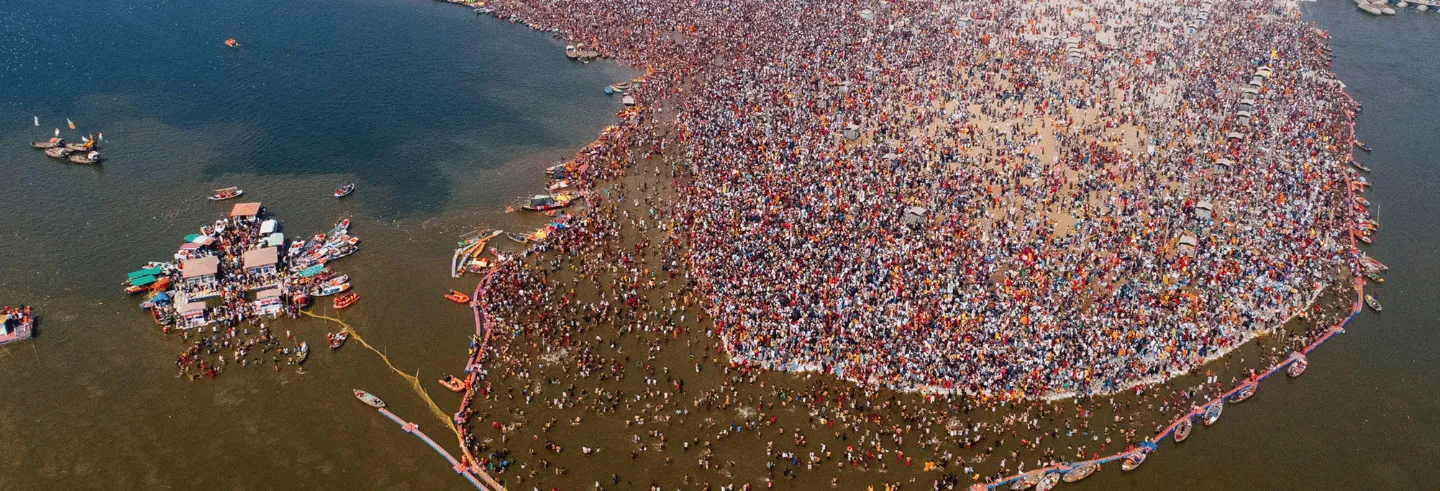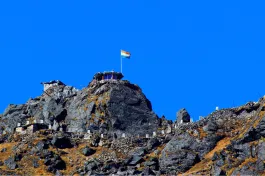As the Vande Bharat train waited for the green signal at the New Delhi railway station, poised to set off on its six-hour-long journey to Prayagraj, I witnessed a scene which has since then reenacted itself many times on the phone screen. My fellow passengers erupted into enthusiastic chants of "har har gange" and "har har mahadev," suggesting that almost all of them were on their way for a dip in the triveni sangam, the confluence of Ganga, Yamuna, and mythical Saraswati rivers at Prayagraj, formerly known as Allahabad.
The message was simple but potent: if millions are willing to come, it must mean something.
This was in early March, two weeks after the Kumbh Mela had ‘officially’ ended. The mela had been marked by failures of public logistical infrastructure, including a fatal stampede in the very station we were in, choked highways, stalled trains, and episodes of violence. Yet, in a testament to the unprecedented excitement around the mela, trains remained packed with passengers seeking to participate in the experience of immersion in the sangam even after the event was ‘officially’ over.
Official estimates recorded 660 million participants at the mela. The exaggerated figure was likely an artefact of an administration working to produce a number that pleased its political leadership. Even so, the participation was at an unprecedented scale. A relentless promotional campaign by the government, its dramatic amplification in visual and social media gathered into a current towards the event. Rich and poor, young and old, all drifted along to register their participation.
The massive participation at the Kumbh fits into the pattern of state-promoted pilgrimages marked by a heightened publicness, oversaturating media, resignifying public infrastructures, and dominating public spaces. Under the stewardship of the Bharatiya Janata Party, such publicness embedded in Hindu pilgrimages is instrumentalised to draw boundaries, lay claims, and define a Hindutva public.
Scale as proof
The contemporary public pilgrimage builds upon the logic of scale that is often a core feature of religious practices which involve coalescing of a congregation. The scale of this congregation serves to instantiate and demonstrate the power of the event and its associated beliefs. Online social networks and media can now digitally beam the scale of such events to the viewer in aesthetic forms like never before. The ensemble of images and videos incessantly streamed to viewers are geared to produce the feeling of being left out.
Nowhere was such a logic more potently at play than the Kumbh Mela itself. Ministers, godmen, and television anchors echoed a mythology that cast the Kumbh as both ancient beyond measure and rare. Claims like the 'once in 144 years' narrative were not ‘false’ claims; they were strategic devices to inflate the symbolic weight of the event across time. They carefully constructed a promise of participating in something eternal yet fleeting, in a ‘timeless’ moment that arrived but ‘once in a lifetime'. That promise proved irresistible.
Countering such claims with factual corrections had little success when the event itself overwhelmed the senses and when scale became evidence of belief. The message was simple but potent: if millions are willing to come, it must mean something. It was the overwhelming turnout that confirmed the sanctity of the ritual bath, and not the other way around.
When the image of endless human masses becomes its own form of ‘proof’, history and statistics are rendered powerless. It is not a simple instance of ‘misinformation’ that is at work: it is the emotional and visual force of the gathering that wins.
This logic was demonstrated in a dramatically stark fashion. Even as images and news of deaths owing to stampedes at the mela made the rounds, and reports revealed that the river waters were too toxic to bathe, people continued to flow in to Prayagraj to participate in the Kumbh. Nor were they deterred by stories of traffic jams running for days on end, or the overcrowding at railways stations and on the trains, or the ridiculously high air fares. It was not faith alone that moved the millions. It was the sense of belonging within a vast gathering of humanity: an invitation to be part of a myth, performed live, on a scale few could ignore.
To a lesser degree, this logic of mass participation lending spiritual weight holds true for other pilgrimages too. Each year, scores of devotees known as Kanwariyas undertake long, punishing journeys, walking or driving hundreds of kilometres with water drawn from the Ganga, which they later offer to Shiva temples across northern India. Devotees trace the origins of this Kanwar Yatra to the mythical figure Parshuram – an avatar of Vishnu and an ardent devotee of Shiva – believed to have taken part in the first such pilgrimage. That myth continues to shape the scale and sentiment of the event.
The Kanwar Yatra is no longer simply a religious act; it has become a vast, moving spectacle, where scale itself becomes sanctity.
The numbers are huge. In 2022, estimates suggest that close to 40 million devotees collected water from Haridwar alone. The following year, during just a twelve-day period in July, over 4.6 million vehicles poured into the town, bringing with them more than 40 million Kanwariyas—among them, over two million women. The Kanwar Yatra is no longer simply a religious act; it has become a vast, moving spectacle, where scale itself becomes sanctity. The big turnout is not merely a reflection of faith. It has become part of the faith’s public performance.
This holds true also for the renewed emergence of Ayodhya and Varanasi as destinations for religious journeys. The Kumbh journey to Prayagraj was turned into a pilgrimage circuit of sorts with participants including Varanasi and Ayodhya in their itinerary as well. Varanasi has witnessed a renewed appeal as a religious destination after the state led high decibel inauguration by Prime Minister Narendra Modi in December 2021 of the Kashi Vishwanath corridor – the redevelopment of Kashi Vishwanath temple and its vicinity. This was followed by the inauguration of the newly built Ram mandir, on the site of razed Babri Masjid, at Ayodhya in January 2024, presided again by Modi, which the Hindu Right marked on its calendar as a day of triumph. Both events served to heighten the significance of these two cities as popular religious destinations.
Such amplification of the logic of mass participation by state and the media, is thus a main contributor in the emergence of the very public character of the contemporary pilgrimage. Consultancy firm KPMG notes in a report that with more than 450,000 religious and cultural sites spread across the country, India offers a vast landscape of sacred destinations. Religious motivation continues to be a major force behind domestic tourism, accounting for over 60% of it. Especially in the post-pandemic era, spiritual travel has emerged as a key driver of tourism, drawing increasing numbers of seekers from across the globe, says KPMG.
A political takeover
Mass pilgrimages and festivals have emerged as potent sites for the Hindutva ecosystem to stir up religious fervour, iterate a ‘united’ Hindu identity over differences of region and caste, lay claim on public infrastructure and enforce boundaries vis-a-vis Muslims and other religious minorities. In its quest to make pilgrimages as sites of a public culture rooted in Hinduism, the government has literally concretised public infrastructures: building highways to religiously significant sites, and redeveloping pilgrimage cities – often ignoring the environmental and human costs.
In response to the BJP’s electoral utilisation of religious events, the political opposition has largely attempted a competing public display of Hindu affection.
During the Kanwar Yatra last year, district and police administrations in Uttar Pradesh ordered eateries along the pilgrimage route to display the names of their respective owners, ostensibly to avoid ‘confusion’ amongst yatris. This dictate followed claims by local Hindutva outfits that the yatris’ faith would get ‘corrupted’ by eating meals at Muslim-owned eateries.
Underpinning such claims is a zeal to further politically and economically isolate an already marginalised Muslim community. At the latest Kumbh Mela too prominent figures like the head of the Akhil Bharatiya Akhada Parishad openly demanded a ban on Muslim vendors operating within the mela premises. Towards the end of January, a ‘Dharam Sansad’ on the mela grounds brought together a mix of fringe Hindu organisations and self-appointed religious leaders. The meeting quickly turned incendiary, featuring inflammatory speeches that called for extreme measures: the seizure of properties under Waqf control, the scrapping of the Places of Worship Act, and the creation of a ‘Sanatan Board’ aimed at enforcing Hindu interests.
What unfolded was not just religious discourse. It was a show of political posturing dressed in spiritual garb, using the scale and sanctity of the Kumbh as a backdrop for majoritarian messaging. This playbook has been deployed in celebrations across cities and towns during festivals like Ram Navmi, Holi, or Dussehra. Large processions of men and women carrying weapons, shouting slogans, dancing to techno-Hindutva music and drum beats, menacingly pass along mosques or Muslim neighbourhoods.
In response to the BJP’s electoral utilisation of religious events, the political opposition has largely attempted a competing public display of Hindu affection. Non BJP parties in power have used state machinery to promote events associated with Hinduism and Hindu figures. The promotion of the Gangasagar Mela in West Bengal, where the Trinamool Congress-led government claimed that 11 million people participated this year, as the ‘revival’ of an alleged ‘ancient’ pilgrimage festival is a glaring example. While the key difference is the relative absence of anti-Muslim rhetoric which invariably marks Hindutva promoted events, state promotion of such festivals contributes to the normalisation of the publicness of Hindu pilgrimages.
The pilgrim beyond Hindutva
Whether such promotion leads to electoral success is dependent on the host of contingent factors that influence voting behaviour. The inauguration of the Ram Mandir in the run-up to the 2024 Lok Sabha elections and the throng of devotees to Ayodhya were touted by the BJP as a triumph for Hindutva. Yet it did not translate into votes for the BJP, which failed to reach the majority mark nationally, and lost in more than half the parliamentary seats in Uttar Pradesh. (In the prior, 2019, general elections, the party had won in 62 of the 80 constituencies.)
An assertion of religious identity could be a desire for social mobility and recognition, and search for identity in a global multicultural context.
There is more to the collective dynamism of contemporary pilgrimage than mere political promotion. For marginalised youth, the Kanwar yatra is a site where fun and entertainment, sport, and caste pride find articulation in religious fervour, and in turn produces a sense of belonging in the Hindu identity. An assertion of religious identity could be a desire for social mobility and recognition, and search for identity in a global multicultural context. It is not difficult to imagine the vast spectacles at Kumbh serving as powerful affirmation of such an aspirational Hinduism.
Thus, while contemporary pilgrimages offer a fertile ground for Hindutva, their popularity and participation may not always be reduced to it. The public Hindu pilgrimage is not merely a reinvention of tradition, shaped as much by ancient myths as by modern yearnings, by political interests as by popular desires. It is a collective, performative expression of belonging, identity, and power. It is in its moments – where faith meets infrastructure, where media spectacle meets administrative ambition, and where devotion intersects with political assertion – that the evolving contours of the Hindu public are being drawn.
Amitanshu Verma has a PhD in political science from Jawaharlal Nehru University and is associated with Centre for Financial Accountability, New Delhi.










Missing the point